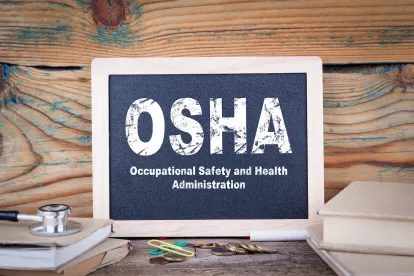Nearly every essential business that remains open during the Coronavirus Disease 2019 (COVID-19) pandemic is faced with the possibility that coronavirus could show up in the workplace, or that its employees are concerned that it will. This leaves employers with the potential to receive a complaint from the Occupational Safety and Health Administration (OSHA), the principle federal agency designed to ensure workplace safety, a sub agency within the U.S. Department of Labor (DOL). Because these complaints require a written response within a week, employers must be ready.
As of early April, nearly 4,000 complaints have already been filed with OSHA across the country. These complaints claim employers have not done enough to protect employees from COVID-19, including claims of insufficient personal protective equipment (PPE), a lack of COVID-19 response training, and the failure to maintain social distancing in the workplace. Of those complaints, just under 30% of them were from the health care industry, and the other 70% came from various sectors, including manufacturing and retail.
So what do employers need to know? OSHA has now issued an Interim Enforcement Response Plan to guide its area offices and compliance safety and health officers in handling and responding to COVID-19 complaints. The enforcement plan includes instructions for regional offices to assess complaints, when inspections may be warranted, and to move certain claims to the top of the priority list. Importantly, OSHA is directing its officers to maximize their review electronically before attempting an inspection and will consider an employer’s “good faith efforts” to comply with OSHA standards.
In response to an OSHA complaint, and to potentially avoid an on-site inspection, employers should be prepared to provide the following information to OSHA:
-
A written pandemic plan as recommended by the CDC.
-
Procedures in place for hazard assessment and protocols for PPE use with suspected COVID-19 employees.
-
A summary of decontamination procedures.
-
Recorded and maintained medical records related to worker exposure incidents and other OSHA required recordkeeping, including whether any employees have contracted COVID-19, have been hospitalized as a result of COVID-19, or have been placed on precautionary removal or isolation.
-
Where applicable, information regarding the respiratory protection program, and respirator policies related to COVID-19, in compliance with 29 CFR § 1910.134.
-
Training records, including records of training related to COVID-19 exposure and prevention.
-
Documentation and provisions created regarding obtaining and providing appropriate PPE (though OSHA is instructing its field offices to exercise “discretion” when assessing PPE complaints, considering the nationwide shortage during the outbreak).
-
Where applicable, information regarding airborne infection isolation rooms or areas and periodic testing procedures. (OSHA is referencing previously published Tuberculosis guidance).
Employers should also keep in mind the relevant OSHA standards at play. There is no specific OSHA standard that covers COVID-19. However, the recent guidance has provided a list of OSHA standards that may be applicable:
-
29 CFR § 1904, Recording and Reporting Occupational Injuries and Illness.
-
29 CFR § 1910.132, General Requirements - Personal Protective Equipment.
-
29 CFR § 1910.133, Eye and Face protection.
-
29 CFR § 1910.134, Respiratory Protection.
-
29 CFR § 1910.141, Sanitation.
-
29 CFR § 1910.145, Specification for Accident Prevention Signs and Tags.
-
29 CFR § 1910.1020, Access to Employee Exposure and Medical Records.
-
Section 5(a)(1), General Duty Clause of the OSH Act.
Most commonly referenced is the General Duty Clause, 29 USC 654(a)(1), which requires employers to furnish to each worker:
employment and a place of employment, which are free from recognized hazards that are causing or are likely to cause death or serious physical harm.
This clause has been interpreted to require employers to understand their industry and safety standards, provide information to employees regarding rights and duties, and to generally ensure that employees have available safe tools and equipment in their workplace. A violation of the general duty clause exists when: (1) the employer failed to keep the workplace free from a recognized hazard that (2) caused or was likely to cause death or serious physical harm and (3) a feasible option existed that – had it been implemented – would have materially reduced the likelihood of the existence of the hazard.
Overall, the guidance explains that the most recent CDC guidelines should be used to assess potential workplace hazards and – importantly – to evaluate the adequacy of an employer’s protective measures for its workers. This means employers should continue to monitor the CDC website and update their procedures and actions based on the most current CDC recommendations.




 />i
/>i

